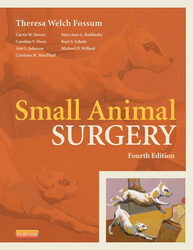「重要なお知らせ:日本語書籍をご購入いただき、eLibraryをご利用の皆さまへ」
エルゼビアは、より快適にサービスをご利用いただくため、システムの重要なアップデートを実施いたします。
現在、新サイト、eBooks+への移行が進められています。
新規ユーザー登録および書籍の登録はElsevier eLibraryでは停止しております。
12月15日以降に
こちらよりご利用・ご登録ください。
Book Description
The fourth edition of Small Animal Surgery serves as a one-stop resource for authoritative information on all aspects of small animal surgery. Coverage includes basic procedures such as spays, castrations, and declaws, as well as more advanced surgeries like craniotomy, ventral slots, and lung lobectomy. New contributors bring a fresh perspective and discuss the latest advances in key areas such as imaging modalities, regenerative medicine, minimally invasive surgery, and neurology. Access to a companion website provides a fully searchable version of the book, bi-monthly content updates, videos, aftercare instructions, case presentations, and a fracture planner.
- Well illustrated, step-by-step instructions for surgical techniques provide quick reference to practical how-to information in emergency and clinical situations.
- Coverage of cutting-edge imaging techniques, including radiographs, CT, MRI, and digital imaging, explores the most useful imaging modalities for demonstrating areas of surgical concern.
- Access to the continually updated companion website for the life of this edition includes:
- Bi-monthly content updates provide cutting-edge information on surgery developments
- Video clips of step-by-step surgical procedures
- Customizable and printable aftercare instructions
- Interactive Fracture Planner
- Case presentations
- Neurosurgery video clips
- References linked to PubMed
- Over 1500 full color images offer exceptionally clear representations of anatomy and currently accepted surgical techniques, including approaches and closure.
- Anesthesia Protocols offer easy access to recommendations for anesthetizing animals with particular diseases or disorders.
- Notes boxes call attention to specific data, offering at-a-glance access to key information.
- A new chapter on neurologic examination provides a solid foundation in neuroanatomy, electro-diagnostics, and basic MRI physics and principles, enabling you to perform a proper neurologic exam to detect problems in cats and dogs, some of which can be corrected via surgical repair.
- A new chapter on regenerative medicine provides the most current information on stem cell research.
- Differential diagnosis tables and boxes offer quick access to vital information, including how to avoid misdiagnosis of disorders that may mimic more commonly encountered surgical neurologic problems that are not actual disorders requiring surgical repair.


 (0 rating)
(0 rating) 





